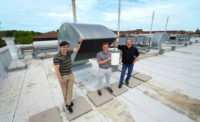"The new A.K. Suter Elementary School has a lot of features found in high-performance buildings," said Roger McGraw, P.E., mechanical engineer for ECSD Facility Planning. "The walls are constructed with insulating concrete forms (ICF) and a vapor barrier, so the building envelope is well insulated. The new HVAC system is state-of-the-art — two ultra-efficient variable-speed centrifugal chillers with Danfoss Turbocor compressors ensure efficient chilled water production. The chilled water is supplied to several air-handling units (AHUs) and over 100 variable-air-volume (VAV) boxes each using Danfoss AB-QM pressure-independent balancing and control valves to optimize flow. This combination of technologies inside the ICF building envelope saves energy and handles our major comfort challenge – humidity."
Pensacola humidity dampens the learning environment
Located in the Florida panhandle along the northern coast of the Gulf of Mexico, Pensacola has some of the highest humidity levels in the Sunshine State.
"Our summers are pretty extreme,” said Jeremy Oksanen, the project's system designer and mechanical engineer with Premier Engineering Group. “We've got 'air you can wear' from April through October. The design conditions for the A.K. Suter project were 93.9°F dry bulb and 77.7°F wet bulb — and an 80°F dew point at 85°F dry bulb temperature. Translated into relative humidity (Rh), our mornings average 84% Rh and 64% in the afternoons. When humidity is at those levels and the dew point is high, everybody feels sticky, especially students.”
The state of Florida requires between 68°F and 78°F dry bulb set points for all student areas, in addition to some form of humidity control. But, the set point for indoor humidity is not defined. The U.S. Occupational Safety and Health Administration, however, recommends indoor air be maintained within 20%-60% Rh, equivalent to a dew point of 24°F-60°F (minus 4.5°C to 15.5 °C).
"For elementary schools, our dry bulb set points are 72°F cooling and 70°F heating,” said McGraw. “But, our biggest challenge is always how to deal with humidity in an efficient manner. We can get into situations where a room is 72°F, but everybody thinks it's hot and clammy because it's just so humid in there.
"In the old school, we had split-system heat pumps and some packaged rooftop units,” he continued. “However, they were all very old, so we did not have that much control. Due to the humidity, the equipment was in all-cooling mode all the time. That's one reason the energy bills were high."
To measure annual school energy consumption, McGraw uses the metric of millions of Btu (MBtu) per square foot. Older schools, like A.K. Suter, typically use more than 85,000 Btu per square foot per year and higher — an amount McGraw hoped to cut in half with the new HVAC system in the new school.
The second biggest problem McGraw hoped to solve was zoning.
"Zoning is critical for comfort," he said. "When you try to create separate zones for different areas, often it seems somebody, somewhere, is uncomfortable pretty much all the time. As a result, doing zoning right was a requirement for the new system design."
Designing a VAV system with independent hydronic control loops
"We put a lot of thought into how to design a system that combines efficiency and comfort," said Oksanen. “To deliver conditioned air to classrooms, this design is based on using single-duct VAV boxes."
As the name implies, a VAV box is a sheet metal box equipped with an actuator that opens or closes a damper to increase or reduce the supply of air. Each single-duct VAV box used for this project is ducted to an air handler that contains a cooling coil with a 51°F-53°F set point — cold enough for sufficient water vapor to condense on the coil for dehumidification, and then a reheat coil at the VAV box with a variable set point to raise the air temperature to avoid overcooling. The supply air temperature is reset upwards based on humidity levels and valve position to reduce reheat.
"The damper control boosts efficiency by optimizing the volume of air needed to satisfy the room's thermostat and avoid unnecessary heating and cooling,” Oksanen said. "Classroom and administrative areas are served by multizone VAV air handlers. We put a dedicated VAV box in each classroom. Between each classroom, there's a collaboration room for the teachers, which includes bathrooms and storage. That group of rooms also has a VAV box. For administration areas, there is about one VAV box per three offices. Corner offices, conference rooms, or different thermostatic zones get a dedicated VAV box. And, the cafeteria gets its own single-zone air-handling unit (AHU) that can modulate airflow, outside air, and capacity based on occupants."
Just as fan dampers ensure proper airflow, valves are critical to control fluid flow.
The overall system employs supply air fans in AHUs to deliver conditioned air through ductwork connected to the VAV boxes. Then, return air fans circulate the air back to the AHUs.
The cooling coils and reheat coils in the VAV boxes are connected to a four-pipe, variable-primary hydronic system. Variable-speed pumps drive the chilled or hot water through the chiller or boiler loop to supply the coils inside the VAV boxes or AHUs. One pair of pipes circulates chilled water to coiling coils; another pair circulates hot water to reheat coils.
"It can be a challenge to balance and control water flow in a four-pipe system supplying numerous VAV boxes, especially in a variable-primary system where your conditions are constantly changing," said Oksanen.
If the system is unbalanced, VAV boxes on some circuits will receive more water than required. In effect, those circuits "steal" flow from other circuits. The first circuits are in overflow, which creates underflow in other circuits. The underflow VAV boxes do not get sufficient chilled or hot water to meet the cooling and heating requirements.
Pushing pumps to the maximum is one way to solve the underflow problem. However, this simply increases pressure to increase total flow, which increases pump energy consumption and stresses pumps and valves. Another tactic is to adjust supply water temperatures to meet the requirements of the VAV boxes in the underflow circuits, but that also wastes energy.
Now solving hydronic circuit balancing problems is easy
Standard manual control valves cannot solve the overflow/underflow balance problem.
"When you have variable-primary systems, we can never depend on manual balancing valves," McGraw said. "That's because the system rarely operates in the same conditions to allow manually balancing the system.
"Instead, we like using Danfoss AB-QM pressure-independent control valves,” he continued. “They replace the typical two-way balancing valve and control valve pair that usually gets installed on the return flow side of VAV cooling and heating coils. For this project, every VAV box and AHU gets a AB-QM valve, totaling about 130 valves. The valves ensure flows are balanced in the entire operating range of the system."
To balance the system, AB-QM valves incorporate an integrated differential pressure controller that enables stable control with 100% "authority" — a term that means the AB-QM valve has complete control of the pressure drop in the system. As a result, at partial loads, there is no overflow because the AB-QM valve will always limit the flow to exactly meet requirements. From a system design standpoint, installing AB-QM valves divides the entire system into completely independent control loops.
Segmenting the hydronic distribution piping into independent loops or "modules" ensures the design flow — which, in this case, is typically 6 gallons per minute (GPM) — is available at all the VAV terminal units at design temperature set points. Thus, the AB-QM valve is the key that unlocks the three requirements for optimal system balancing by: 1) Supplying design flow to all terminal units at design conditions; 2) Minimizing variation in the differential pressure (pressure drop) across the control valve; and 3) Ensuring the water flow is compatible with system components and interfaces.
McGraw also appreciates how the AB-QM valve is easy to work with.
"I like keeping each VAV box within the engineer's design set point," he said. "If a new piece of equipment is added, and I need to change the flow because folks are a little bit uncomfortable, the AB-QM valve makes it easy. All I have to do is change the dial to either a 10%, 15%, or 20% increase in the flow and it happens. I don't have to hook up a computer. I don't have to change out the cartridges in the valve components. I just take the valve head actuator off and dial it in. In a couple of minutes, the AB-QM actuator re-learns everything. It's simple compared to a manual balancing valve or auto-flow valves with cartridges."
For that reason, AB-QM valves also simplify commissioning.
"If you're using a spring-based flow valve that is set at the factory, it can be a lot of trouble if it is ordered wrong,” said Andy Heitman, energy consultant/commissioning authority at Building Energy Sciences LLC, who commissioned the project. “You have to open up a conventional automatic flow control valve or automatic flow limiting valve, get a new cartridge, and re-insert the cartridge.
"Conventional flow valves also complicate the commissioning process," he continued. "When you look at the automatic flow control valve, the only thing you see is a tag hanging on the side. You are forced to conclude, 'OK, it says it is factory set at 5 gpm. So, it must be 5 gpm.' But, with an AB-QM valve, you can see it has a dial from 0-10. So, if the clickstop setting is 6, the nominal flow rate will be the same as the measured flow rate. What you see is what you're actually getting. It's that simple."
Another benefit is the energy efficiency resulting from proper valve seating.
"In old buildings in our school district, there's no telling how much energy gets wasted by leakage due to improper valve seating," said McGraw. "A central AHU may be pushing out 53°F air to a VAV box. However, if hot water is leaking through the valve into the reheat coil, the air is then being heated needlessly. Consequently, the damper on the VAV box opens to supply more and more air for cooling, so people are comfortable. But, it's wasting a ton of energy. In contrast, the AB-QM valve automatically knows how to seat itself to a fully closed position. I don't have to worry about it."
Variable-speed, oil-free centrifugal chillers easily handle part-load problems
To generate chilled water at the 44°F set point, two water-cooled centrifugal chillers are employed, each using two Danfoss Turbocor TT400 variable-speed magnetic-bearing compressors. Each pair of compressors deliver 250 ton of nominal cooling capacity per chiller.
Together, the two chillers provide what is known as "N+1 redundancy," meaning that one chiller is available as a standby or backup as well as being available to provide additional capacity in the event of school expansion.
In day-to-day operation, the chillers take advantage of the Danfoss Turbocor compressor's extraordinarily high efficiency at part-load conditions.
"Part-load efficiency is really important in this application," said McGraw. "The ICF building envelope is very effective, so ambient conditions outdoors have little effect on the cooling load."
McGraw calculates that the lead chiller runs at 60% capacity 85% of the time and below 20% capacity nearly one-third of the time. It goes above 80% capacity only 3.3% of the total operating hours.
That's where the maximum benefits of Danfoss Turbocor magnetic-bearing variable-speed technology are realized.
"A constant-speed centrifugal chiller is spinning the centrifugal impeller at maximum RPM regardless of outdoor conditions," said Oksanen. "When full cooling capacity isn't required, mechanical throttling vanes or valves can be used to reduce the chiller's capacity. However, the motor is still running at full RPMs, which wastes energy."
With Danfoss Turbocor compressors, the shaft/impeller speed is reduced and — in combination with the integrated vane assembly (IGV) — capacity can be "turned down" to match the cooling load required. To reduce speed quickly and reliably, the Danfoss Turbocor compressor uses a synchronous permanent-magnet brushless motor.
Each motor is integrated with a variable-speed drive (VSD) that controls the voltage and amperage. VSD technology makes it easy to change speed by reducing the frequency of the current supplied to the motor. The VSD varies frequency between 300-800 Hz, which provides a compressor-speed range from 9,000-29,000 RPMs without using a gear set.
Efficiency is further enhanced by the oil-free magnetic bearings, which eliminate the friction associated with using traditional contact bearings. In a Danfoss Turbocor compressor, the rotor is levitated by magnetic forces of attraction/repulsion forces rather than riding on bearings coated with a film of oil.
The absence of oil lubrication eliminates the efficiency losses that can occur when oil fouls a chiller's evaporator tubes. Tube fouling decreases heat transfer. One study shows that as little as 3.5% oil content in a refrigerant charge can reduce efficiency as much as 8%.
"Eliminating oil also cuts out the costs of oil handling, changing and disposal," said McGraw. "Plus, with permanent-magnet motors, noise and vibration is minimal. These chillers are so quiet, you hardly know they are running. They are perfect for a school environment."
To enhance chiller reliability, the compressor's oil-free operation eliminates the problem of inadequate oil circulation at part-load conditions. In oil-lubricated chillers, oil can enter the refrigerant circuit and accumulate in the evaporator when RPMs decrease. Normally, excess oil stays in the compressor's oil sump. But, when RPMs drop, oil accumulates in the evaporator, which can cause the chiller to shut down. Otherwise, the excess oil tends to displace refrigerant at the top layer of evaporator tubes, further reducing heat transfer and chiller efficiency.
Without these complications, oil-free Danfoss Turbocor compressors achieve high stability and efficiency resulting in a high integrated part load value (IPLV), which is the measure of chiller efficiency over a range of operating conditions.
Because 80% and higher capacity is required for only about 3% of the chiller’s operating hours, the high IPLV means the chiller is saving energy during 97% of annual operating hours. For the A.K. Suter application, the Danfoss Turbocor-enabled chillers are consuming only about 0.45 kW per ton — nearly 50% less than a constant-speed chiller.
"In fact, our chillers can turn down capacity as low as 17% in winter, when colder tower water makes it possible to lower condenser water temperature down to 65°F," said McGraw. "In summer, although condenser water doesn't get colder than 85°F, we rarely operate at full capacity due to lower building loads."
Varying flow with variable-frequency drives
McGraw also found the Danfoss Turbocor-powered chiller can handle less chilled water flow than other chiller designs.
"The chiller brand we went with doesn't require as much water and, therefore, uses less pressure [lower pressure drop] to move water through the evaporator,” he said. “That becomes significant over time. After 20 years of pumping, if you can reduce head pressure across the chiller by 10 feet, you'll save a lot of pump energy."
Energy is also saved by using VSDs on all eight pumps employed in the system (one VSD per pump). Similar to how a VSD is used on compressor motors, changing the frequency of the current changes pump speed to match flow requirements. The RPMs of the pump must be variable to allow for a slower speed when there is little demand for water and a higher speed when more water is needed. This allows the operator to match pump speed with water demand, which saves energy and reduces stress on components.
The VSD pumps in conjunction with AB-QM valves also eliminate water hammer. This problem is common in hydronic loops when pressure surges inside a pipe, causing noise, vibration, and the possibility of serious pipe damage.
VSD technology is also used on fan motors. Each cooling tower fan incorporates a VSD. The exhaust and outside air fans associated with the energy recovery use VSD to ensure proper airflows due to filter loading and other conditions. All AHU fans are multizone variable-volume or single-zone variable-volume designs employing direct VSD motors.
Top grades in teamwork, too
With all the advanced technology needed to handle the variables of efficient air and water flow, McGraw appreciated the support from Danfoss.
"Our Danfoss distributor, Danny Agnew, vice president of Lanico Inc., was really good,” he said. “He personally set the flows and tagged every one of the AB-QM valves before he gave them to the controls guys. And he was great from a technical perspective early in the design phase by bringing us products to consider and convincing us to take the dive on these valves."
According to Heitman, support was also very good during and after commissioning.
"Danny helped educate the controls contractors,” Heitman said. “After that, they were good to go. For the few user error issues during installation, he would run out to the job site, look at it, and help the contractors learn their way through it. The support has been very, very good.”
In the end, McGraw was delighted to see new A.K. Suter Elementary School finish at the top of the class from an energy and comfort standpoint.
"The yearly energy use for old elementary schools in ECSD is over 0.080 MBtu per square foot,” he said. “I was hoping the new A.K. Suter Elementary School would drop at least 50% to below the elementary school average of 0.045 MBtu. The performance is really stellar — just 0.024 MBtu per square foot — far below any public elementary or high school in Escambia County. That level of performance can be achieved with state-of-the-art building design and HVAC technologies. We learned valuable lessons in efficient air and fluid flows from Danfoss we look forward to applying in other schools."





